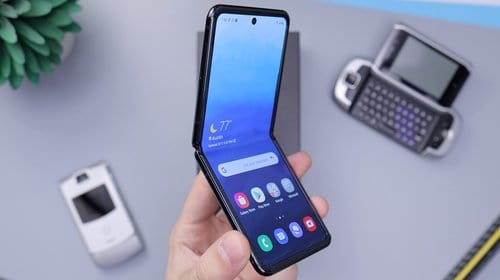
With new electronic gadgets being distributed every year, one might find it necessary to keep up with the Joneses of new technology. While doing so satisfies the conscious need to remain up to date with societal trends in consumerism, is dishing out the cash so frequently really worth it in the long run?
Why do gadgets lose value quickly? Gadgets lose value quickly because of the frequent release of newer gadget versions for sale. As a result, companies are caught up in the constant cycle to release more reliable and faster gadgets to replace the declining software of last year’s smartphone, tablet, laptop, or TV.
Depreciation rates vary from gadget to gadget. Rates can be dependent on the brand of the gadget because different brands depreciate at different rates. There are many factors to consider when purchasing a new gadget and a little research may be worth all the while before jumping too quickly at that new release you’ve been anticipating.
Depreciation And Gadgets
So, how do depreciation rates and gadgets go hand in hand? Well, like the saying goes, all good things must come to an end. Or perhaps in this case, the high value of all new gadgets must depreciate in the end.
There tends to be the undeniable trend of something new quickly being replaced by an even newer version and disappearing into the infamous consumer dump pile of last year’s old news. In some cases, gadgets are replaced by a completely new product or in others, by an updated or reinvented version of the old one no longer in production.
Who’s to Blame?
Considering that “newly released” is what almost always sells best, and sales are driven by consumer demand, it is completely reasonable to place the blame for the rate of depreciation value of a product squarely on the consumer.
Consumer demand, however, is not always the case for a gadget’s depreciation value.
It is, unsuspectingly, the companies that are to blame for the depreciation value of their own products. As companies push better and newer gadgets onto their consumers, their value decreases as a result of the company feeling pressure to keep up with the cycle.
As ludicrous as it sounds, it’s actually a great method of marketing for grasping the attention and maintaining the business of loyal consumers.
In the vast pool of consumer gadgets, innovation is the key to success and companies feel obligated to provide high-quality gadgets on a constant basis to their loyal customers.
The Apple Effect

Does this whole depreciation value phenomenon sound familiar? If you’ve been an avid consumer of the famous Apple iPhone or any Apple product thereof, it’s no surprise that the company is noted for its influence on the prevalence of gadget value depreciation so much, that its influence has been branded, “the Apple effect.”
Urban Dictionary, the hub of all slang known to mankind, defines the Apple effect as, “The effect of a new version of a product being released by Apple that is no better than the previous one.”
The Apple effect is not only known for its effect on new gadget consumption, but on the stock market and the global electronic gadget market overall.
Gadget Release Patterns
So, why does Apple insist on releasing so many updated versions of their gadgets back to back? First, let’s take a look at some of their most recent release patterns.
InfoNewt, a web platform dedicated to reporting data to the consumers of various companies, is a useful source for observing the data surrounding the release pattern of Apple gadgets and such. They provide release reports of all gadgets released by the company spanning from 2007 to 2019, along with the specific year-by-year patterns of each gadget.
The product line of Apple is immensely expansive from iPhones and iPads, to MacBook Pros and MacBook Airs, the list goes on. The infamous iPhone is no stranger to having a high release rate and the patterns outlining that data speak for themselves.
According to the release pattern chart for iPhones, from 2007 to 2019 the company released a new phone every year, and 2017 and 2018 were the only years in which the company released more than one updated and newly released iPhone models.
Additional detailed release patterns of Apple gadgets are available here.
Depreciation Rate by Brand and Gadget
Generally, the depreciation value of a gadget increases the minute it is purchased. However, the rate of depreciation is dependent upon multiple factors, with two of them being the type of gadget and the brand of the gadget.
Smart Phones

The depreciation rate of smartphones is highest of any other gadget on the market and is steadily increasing by the minute. Smartphones have become the staple of modern-day technology as they are just as much of a necessity nowadays as telegrams were back in the day.
“Cell phones don’t depreciate linearly over time. They lose a lot of value right away and then gradually less over time.”
Source: Rohin Dhar at Priceonomics
Smartphones depreciate at a value of between 33% to 75% within one year from the date of purchase. And then the rates are guaranteed to increase or decrease by the rate depending on the brand. The data highlighted in the next few sections are reflective of the top three smartphones brands in the U.S.: Apple, Samsung, and LG.
Apple
Apple Inc. is by far one of the biggest leading brands in the vast market of technological gadgetry in the U.S. Ever since the release of its first smartphone, the iPhone on June 29, 2007, the tech giant has been producing high-end gadgets at an increasingly fast rate in order to meet the needs and demands of their consumers. Over the course of 13 years, Apple has released nineteen variations of the iPhone spanning thirteen generations in total… model generations that is!
With their quick approach to innovation, it comes as no surprise that their smartphones tend to depreciate at a lower rate over time due their make and quality. All models remain functional. However, only the smartphones of the last five generations are supported by the latest iOS version.
The table below list the five most recent generations of the iPhone along with the depreciation rate in value of each model gadget, with Gen 13 being the most recent.
| Generation 9 | iPhone 6S / 6S Plus iPhone SE |
| Generation 10 | iPhone 7 / 7 Plus |
| Generation 11 | iPhone 8 / 8 Plus iPhone X |
| Generation 12 | iPhone XS / XS Max iPhone XR |
| Generation 13 | iPhone 11 / iPhone 11 Pro iPhone 11 Pro Max |
The depreciation rate of each new Apple smartphone averages between 25% and 62% after the first year of purchase, with the most recent releases, iPhone XS and XR models, averaging a depreciation rate of 11% from initial release.
Samsung

The South Korean owned brand of all things tech, Samsung, is the second most popular brand among smartphones distributed in the U.S. They are also second best when it comes to smartphone depreciation rates.
Judging by the last three most recent smartphone releases from Samsung, the depreciation rates average between 45% and 75% a year after their initial release date.
There’s no particular reason for why Samsung smartphones depreciate in value, depreciation affects all make and brands of gadgets.
LG
Life’s Good, more popularly known as just LG, is a company that produces an array of technological gadgets and home appliances spanning from smartphones, to washing machines and refrigerators, to standard digital cameras.
Of all the brands explored in this article, LG smartphones have the highest rates of depreciation in value. The high rate of depreciation in smartphones from LG may be due to the fact that they are not as of high value as their competitors.
The average depreciation rate of the most three recent LG smartphones averages between 55% and 85%.
Laptops
Depreciation rates of laptops are not as publicly available as those of smartphones are. One reason that may be contributing to this issue is that, with the depreciation rates of laptops, the price is more or less taken into priority consideration than say, the make or model.
Laptops depreciate in about a third of their value each year from their initial date of purchase.
The brand of the laptop has a slight factor in the depreciation rate; however, the price is the key factor in estimating the depreciation rate of a laptop. Dell, Apple, and Microsoft are the leading brands in manufacturers of laptops and thus have lower depreciation rates because of their higher prices and quality.
Tablets and TVs

Given their apparent likeness to smartphones, it’s easy to assume that depreciation rates of tablets perform the same as their close counterparts. The market of tablets has seen a recent decline over the last few years due to consumer attention being driven elsewhere and more preference given towards desktop computers and laptops.
As a result, the depreciation rate of a tablet is best discovered by calculating factors such as the price, make, and model, much like that of a car. The same concept goes for the depreciation rate of TVs. It is dependent on the price, make, and model.
A useful article for calculating the depreciation rate of a television can be found here.
Buying Refurbished vs. Pre-Owned
For the many consumers unwilling to splurge hundreds and thousands on new gadgets for the sake of frugality or simply being unable to afford it, buying refurbished or pre-owned might be a more ideal option for updating your gadget inventory. Both options allow for access to like-new gadgets without having to completely empty out your pockets.
It may be news to some that there is even a difference between a refurbished and pre-owned gadget and depending on which way you decided to purchase your gadget, there are pros and cons to weigh with both.
Refurbished
A gadget that has been refurbished has undergone refurbishing through the same company that manufactured it when it was first made. This means that a certified tech specialist looked over and repaired any prior damages or mishaps to the gadget before clearing it for resale.
Pros of buying refurbished:
- Any prior damages are repaired by the manufacturer or seller
- Warranty is provided with purchase
- In great or like-new condition
- Can save you money vs buying brand new
Cons of buying refurbished:
- May be of a higher cost than a pre-owned or used gadget
- Not brand new
Pre-Owned
There are two types of pre-owned gadgets:
- Certified pre-owned
- Used (pre-owned without certification)
There isn’t much of a difference between the two and truly, the degree of the variance depends on consumer preference and expectation.
Certified Pre-Owned Gadgets
Pre-owned gadgets are not resold through the company that manufactured them. They are second-hand gadgets that range from slightly used to well taken care of quality that have either been returned and then resold or used by a prior user, both without going through a refurbishing process. The most fitting description of a pre-owned gadget is one that isn’t brand new but is in good condition.
Pros of buying pre-owned:
- Lower cost than if you were to buy brand new or refurbished
- Better quality than a used gadget
Cons of buying pre-owned:
- No guaranteed warranty on the gadget if it is damaged or stops working
- There is no certification deeming the gadget “damage free”
Used Gadgets
Used gadgets have been previously used and vary in quality from heavily used to slightly or gently used. Used gadgets have a higher chance of showing signs of use such as cracked screens, faulty functioning, and other cosmetic blemishes. Gadgets that have been used are not of as good quality as pre-owned or refurbished gadgets and there is no guaranteeing the condition they are described in is accurate.
Pros of buying used:
- Lower cost than if you were to buy a pre-owned or certified gadget
Cons of buying used:
- You can’t verify the condition of the gadget described
- No guaranteed warranty on the gadget if it is damaged or stops working
- Gadgets may have signs of cosmetic wear
- No certification deeming the gadget “damage free”
Overall, it comes down to how much you are willing to spend on the gadget and what aspects of purchasing the gadget you are willing to risk.
For more information on buying second hand products, visit here.
For more information on the pros and cons of buying refurbished and pre-owned, visit here.
Buying Safe & Smart
Even though buying a new gadget after every initial release date doesn’t sound like the most ideal habit, it is possible to do so without shelling out high amounts of money. Like any purchase, big or small, saving money requires strategic thinking and planning and doing so may save you a fortune in the long run.
Ways to save money when purchasing gadgets:
- Wait for the item to go on sale
- Buy refurbished or pre-owned
- Sell or trade in the old gadget for money
It is important to verify that you are buying any gadget from a trusted vendor, regardless of the gadget’s condition. Buy from a trustworthy seller such as the original manufacturer or a retail reseller such as BestBuy, Amazon, or Gazelle, to name a few.
Buying safe ensures that you can find guaranteed support should you damage or have issues with your gadget, it could also prevent unnecessary costs.
Also, never pay more than what you believe you should be spending on a gadget just because it’s a fairly newer release. Consider searching around cost conscious options for buying a new gadget and compare the price and feature of each one.
(Gadget) Investing Where It Counts

Investing in any realm requires much time, dedication, and patience. There is no avoiding depreciation, as it is a natural phenomenon in production however, there are ways of working around it. When most of us think of investing, we think of the stock market and putting money into our homes and cars, but often we forget that the gadgets we purchase are forms of investments in many ways.
One way is similar to the stock market strategy of buying low and selling high.
Making a huge profit from this method may not be as attainable with gadgets as the actual stock market, but it might be worth a try or two. The method of buying low and selling high, in terms of the stock market, means buying stock when company prices are down and selling them once the prices begin to fluctuate.
This same method can be taken into consideration when purchasing a gadget, new or older.
Gadgets as Investments
The overall purpose of investing is to purchase something with the intention of getting a substantial return greater than or equal to the value it was purchased at. As mentioned before, investments span beyond the stock market and can include, cars, houses, real estate, etc. Although they don’t retain their value for as long as the investment options listed above do, gadgets can still be useful as investments.
One reason gadgets are worth investing in is because they will always be in demand because consumers are always on the lookout for smartphones, laptops, tablets, and TVs.
One way you can save money is by investing in the pricier, high-quality gadgets. This requires spending more money initially, but in the long run, it can also save you lots of time and money.
Reasons why buying high can save you money:
- Gadget performance is more sustainable and thus less likely to decay quickly, saving you money on repairs or an additional purchase of gadget
- You can trade in or sell the gadget in return for a discount or in exchange for your next purchase
- The high-quality of the new gadget may last well past its expected lifetime and save you more time and money before you need to replace it with a new gadget
Gadgets and the IRS
In some cases, it’s possible to deduct the cost of an electronic gadget for business use. If you purchase a specific gadget for business use, you can calculate the straight-line depreciation rate for tax purposes and receive a deductible for your investment. This is a case where buying high may really pay off in the end.
There are of course, certain aspects to weigh such as the date of purchase and price of the gadget. Some common gadgets eligible for cost deductions are laptops, computers, and tablets.
More information can be found on the Internal Revenue Service’s website here.
Another article outlining the depreciation rate of gadgets is available here.
Avoiding Depreciation in Value of Gadgets
Although completely preventing your gadget from depreciation in value is not likely, it is very much possible to purposely slow the rate of decline by taking matters into your own hands. Taking the extra steps to preserve your gadget’s quality and invest extra money into it can help you avoid depreciation values of your gadgets.
Why Quality Matters
As much as it pays to buy newer gadgets, it pays even more to take care of those older beloved items. Buying a higher-quality gadget provides you the option to sell it or trade it in future wise. This, however, is not worth wasting your time over if the gadget you’re reselling or trading in is damaged or bad condition.
At the end of the day, it’s the quality of the gadget that matters more so than the price it was purchased for but having a high-quality and high-priced gadget is a plus.
Before deciding to put your gadget on the market, consider having any necessary repairs done to ensure that it will function as expected. If your smartphone or tablet has a faulty lock button that has a mind of its own, that is something that would definitely need to be fixed.
Also consider the cost of the repairs and if they will outweigh the initial price of the gadget, if so, it might be best to just sell it as is and invest in a newer model of gadget.
Wait Before Purchasing
Newly released gadgets do not always perform as promised or expected, so it’s not a bad idea to wait before promptly purchasing that new gadget you’ve had your eye on for a while. While they are frustrating to consumers and manufacturers, factory recalls with new electronic gadgets are fairly common and occur often.
Smartphones unexpectedly exploding in the pockets of their users, iPhone systems crashing, we’ve all heard it all before. As with all things in life, plans don’t always come to fruition the way we imagine, and the same goes with new gadgets. This is one reason for waiting before purchasing a newly released gadget.
Sometimes all the hype surrounding the new release of an electronic gadget doesn’t exactly go hand-in-hand with the actual quality of the gadget itself. Perhaps it might be worth waiting if all that lies between your gadget and the newly released version is a tiny camera lens or two, literally.
Consider Buying A Latter Gadget
Buying a latter gadget might be the best option for those of us frugal shoppers more concerned with the practicality of purchasing a gadget and not so much the attention surrounding it. If you’re one to be content with gadgets that do the simplest of tasks and not concerned with all the fancy bells and whistles involved, then buying last year’s model may not be all that bad of an idea to you.
Once the new release of a gadget becomes available, any version or model prior to that automatically drops in value as a result. This might push the product more towards your ideal budget overall and save you a few bucks.
Another opportunity to take advantage of is percentage off. The holidays are the prime opportunity for finding gadgets at a lower price without sacrificing quality.
The months of November to January are the best times to buy new gadgets as companies and stores are pushing to free up their inventory to allow more room for future newly released items. As a result, they sell their gadgets at a highly reduced rate, sometimes even providing consolidation deals where you can buy multiple gadgets for a low price or buy one and get an additional one for free.
Gadget Value in the Long-Run
To sum up the explanation for gadget depreciation rates, it’s all the companies’ fault. Well, not all of them, but they know who they are.
The important thing to remember is how to buy around those brilliant marketing strategies and avoid falling victim to high-priced gadgetry. It’s not always the high price that makes a gadget have value, but rather the overall quality. Prices can fluctuate, but gadgets of high quality always retain their value.
Consider asking yourself a few of these questions next time you purchase a gadget:
- Will the product retain its value for long?
- How much am I willing to spend and for what features?
- Can I get the same performance out a refurbished gadget for a lower price?
- How much of a return will I get for investing in this gadget?
When considering these questions, think about the pros and cons of each or write them down on paper. If the cons outweigh the pros, try waiting until the right gadget comes along and meets all of your needs and desires.
